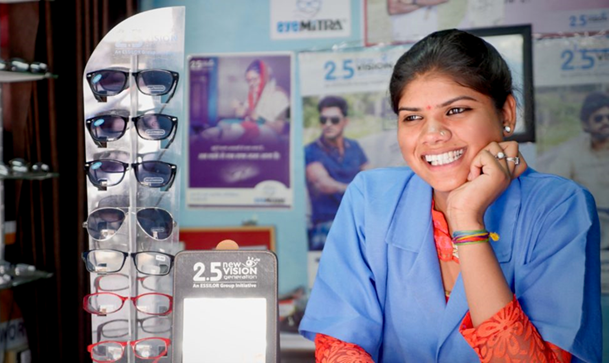
In the field with Essilor
At a glance
- As the global leader in prescription lenses, Essilor decided to address the problem of poor vision due to uncorrected refractive error, which affects 2.5 billion people.
- The company launched the Eye Mitra program in India, where it helped people set up fixed access points in their rural communities to provide prescription eyeglasses. This required innovating across the value chain.
- Essilor’s social impact foundation covered the initial costs of training and providing set-up equipment to the Eye Mitras, i.e. primary vision care providers.
- In 2020, Essilor created a roadmap for eliminating poor vision worldwide by 2050 and partnered with governments, NGOs, and other corporates to achieve this goal.
- It committed to creating half of the one million access points required and to working with other organizations to create the other half.
How can companies lead initiatives to address major global problems?
Research commissioned by Essilor in 2010 showed that poor vision because of uncorrected refractive error was a huge global problem, affecting 2.5 billion people. As the global leader in prescription lenses, Essilor decided to take the lead in solving this problem.
In 2013, the company set the ambitious goal of eliminating poor vision by 2050 by ensuring that everyone in the world had access to prescription eyeglasses. Because of the scale of the problem, the company decided to focus on business rather than philanthropic solutions, and on building partnerships with other organizations that could leverage its efforts for maximum impact.
The broader issue
Stakeholders increasingly expect companies to take the lead in solving major global problems when they have the resources and expertise to do so. However, because of the massive scale of these problems, companies are not able to do this alone. They need to work with governments and other organizations that have resources and skills that complement their own. This requires a different approach and a new set of skills that companies and their senior executives will have to master.
A new strategy
Develop an approach that works
Essilor began to experiment with different ways of delivering the service to underserved populations in India in the early 2000s. Rural Indians did not have easy access to prescription eyeglasses since most optometrists were based in urban centers. The company addressed this by launching the Eye Mitra program, which created fixed access points in rural areas. This required recruiting and training people to set up optical shops in rural areas, developing low-cost vision testing solutions, manufacturing products at the four- to five-dollar mark affordable in these markets, and putting in place the infrastructure required to serve these micro-entrepreneurs.
Allocate organizational resources
Essilor set up a Mission Division headed by a chief mission officer who reported directly to the CEO in 2010. The new group had several arms, all of which were important to achieving the mission. These included:
- 2.5 New Vision Generation, its inclusive business arm, which focused on serving rural populations that were not well served by existing distribution channels.
- The Base of the Pyramid Innovation Lab, which developed new business models and technology solutions.
- The Vision Impact Institute, its advocacy arm.
- The Essilor Vision Foundation, which focused on philanthropic solutions for people who needed subsidized or free services.
- Vision for Life, Essilor’s social impact fund, which supported sustainable vision care infrastructure and programs.
Create a roadmap
In 2020, once it had identified approaches that worked, Essilor decided to create a roadmap to achieve the goal of eliminating poor vision globally by 2050. It published a report that laid out the four key elements of the strategy: Creating one million access points globally; increasing awareness of poor vision and its impact so that affected individuals would come forward to be tested and get prescription eyeglasses; innovating to make vision testing easier and cheaper and to reduce the cost of prescription eyeglasses; and ensuring funding for subsidized or free services for people who were unable to pay. This strategy was supported by the most important players in vision health globally.
Partner with other organizations
Given the massive scale of the goal it was trying to achieve, Essilor knew it would not be able to get there on its own. It actively partnered with other organizations to attain the goal of eliminating poor vision by 2050. It helped to orchestrate the global response to poor vision by bringing together stakeholders including governments, NGOs, international organizations and other corporates. It built partnerships with state governments in India to eliminate poor vision. For example, in the state of Orissa, it was working on an initiative whereby Eye Mitras would become part of the primary healthcare delivery infrastructure. It was also funding the expansion of the Eye Mitra program by securing KPI-based grants from other organizations that aimed to achieve other social objectives such as reversing rural to urban migration and achieving gender parity which could also be realized through the Eye Mitra program.
After becoming an Eye Mitra, or even during the course, the way I participated in class like standing in front of the classroom actually helped me reduce my hesitation. Now I can speak freely without any hesitation in front of other people.
– Rekha Kumari, Eye Mitra optician
Did it work?
By 2020, Essilor had established a network of 8,000 Eye Mitras in India, with positive effects on the Eye Mitras (who could earn a good living in their villages rather than having to migrate to cities) and their customers (who were able to correct their vision problems and live a better life). Essilor also began trialing similar approaches in other countries including China, Bangladesh, Zambia and Kenya.
Although there was still a long way to go to reach the goal of eliminating poor vision by 2050, Essilor was optimistic that it was on the right path. It was confident that its approach of adding new access points in underserved areas worked well and was scaling this up. It had committed to helping to set up half of the million access points required itself and working with other organizations to set up the other half.
Essilor was also innovating in areas that it hoped would make it easier to reach the goal. It was supporting efforts to use mobile phone apps for vision testing and was experimenting with more scalable access point options, which could potentially reduce the number of access points necessary to reach the goal.
Reaping the benefits/key takeaways
- Business solutions provide a sustainable way to address major global problems. Given the scale of the problem, with 2.5 billion people worldwide suffering from poor vision, philanthropy would not be sufficient to address the problem. A business solution that addressed the needs of low-income rural communities was better suited.
- Philanthropy is required. Essilor’s social impact foundation covered the cost of training the Eye Mitras, as well as the initial set of equipment they required. As it scaled up, Essilor asked other organizations with complementary goals to help cover these costs. Philanthropy was also required to meet the needs of the poorest consumers.
- Partnering with other organizations is essential. Essilor recognized that it would not be able to solve this problem alone and reached out to other organizations – including governments, NGOs and corporates – to build a global coalition to do so. Investing in advocacy and making the case for eradicating poor vision was critical.
- Innovation is key. Essilor had to innovate in every part of the value chain to develop a business model that worked. It put significant resources into promoting innovation, including setting up an innovation lab, launching open innovation challenges and funding startups pursuing promising ideas.
This article is based on the IMD case IMD-7-2311, available from The Case Centre at this link.
Research Information & Knowledge Hub for additional information on IMD publications
In that article I explained that modern safety leaders need more than just technical skills to survive in a VUCA (Volatile, Uncertain, Complex & Am...
The case study delves into strategic transformation and leadership transitions at Unilever since 2009. Unilever has been an industry leader of busi...
The parenthood wage gap – different wage levels for employees with versus without children – is one of the key factors contributing to gender wage ...
in Safety and Health Practitioner 29 January 2019
Research Information & Knowledge Hub for additional information on IMD publications
Research Information & Knowledge Hub for additional information on IMD publications
Research Information & Knowledge Hub for additional information on IMD publications
Research Information & Knowledge Hub for additional information on IMD publications
Research Information & Knowledge Hub for additional information on IMD publications
in I by IMD 28 June 2024
Research Information & Knowledge Hub for additional information on IMD publications
Research Information & Knowledge Hub for additional information on IMD publications
in I by IMD 24 June 2024
Research Information & Knowledge Hub for additional information on IMD publications
Research Information & Knowledge Hub for additional information on IMD publications
Research Information & Knowledge Hub for additional information on IMD publications






